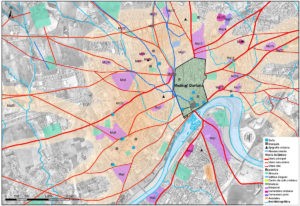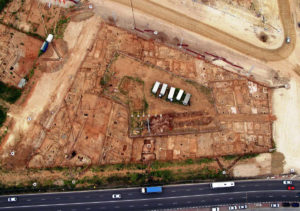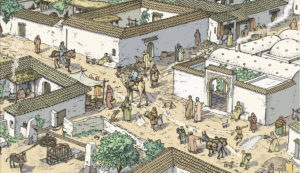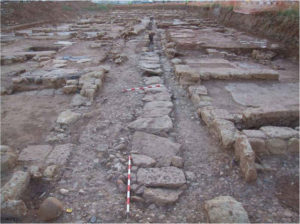
The western suburbs

The process of creation of the medina of Qurṭuba was completed over the centuries, developed purposely by successive rulers in order to Islamize the pre-existing city and adapt it to the needs of the Muslim community. The first transformations began with the emir ‘Abd al-Raḥmān I, although the real urban development of the city did not take place until the establishment of the Umayyad Caliphate in the year 929.

The Qurṭuba of that moment presented two parallel realities: the space within the walls, conditioned by the existence of a previous urban planning in constant evolution; and the city outside the walls, especially extended towards the western area from the 10th century, where a large number of new neighborhoods emerged. Nevertheless, from the second half of the 8th century, the emirs of Cordova had occasionally participated in the construction of these lands.

The archaeological works carried out to the west of Cordoba in the last twenty years have highlighted the size and the splendour of these peripheral areas, which had less than a century of life since they were plundered and abandoned after the fitna or civil war (1009-1031). Due to these excavations, it has been possible to analyze in depth the characteristics of a Islamic urbanism from its origin, and not Islamized, as it happened inside the medina.

These suburbs were built around preexisting roads and new paths and streets. They were constituted by dwellings and other spaces such as mosques, cemeteries, baths, artisanal installations, agricultural areas or hydraulic structures. The almost orthogonal layout of many of these neighborhoods indicates a prior planning that seems to have been orchestrated in large part thanks to the initiatives of private individuals or the actions of “constructive promoters”. However, the Umayyad State could also have been involved in a initial phase.
Bibliography
APARICIO SÁNCHEZ, L. (2008): “La planificación urbanística en la Córdoba Califal. Los arrabales noroccidentales” en BICHO, N. y CARVALHO, A. F. (Coords.): Actas do IV Congresso de Arqueología Peninsular (Faro, 2004), pp. 29-38.
APARICIO SÁNCHEZ, L. y RIQUELME CANTAL, J. A. (2008): “Localización de uno de los arrabales noroccidentales de Córdoba Califal. Estudio urbanístico y zooarqueológico”, Cuadernos de Madīnat al-Zahrā’, 6, pp. 93-131.
CAMACHO CRUZ, C. (2002): “Nuevos vestigios arqueológicos de la Córdoba Omeya. Actuaciones arqueológicas en el trazado de la Ronda Oeste de Poniente”, Arte, Arqueología e Historia, 9, pp. 118-132.
CÁNOVAS UBERA, A; CASTRO DEL RÍO, E. y MORENO ALMENARA, M. (2008): “Análisis de los espacios domésticos en un sector de los arrabales occidentales de Qurtuba”, Anejos de Anales Arqueología Cordobesa,1, pp. 201-220.
CASAL GARCÍA, M. T. (2008): “Características generales del urbanismo cordobés de la primera etapa emiral: el arrabal de Šaqunda”, Anejos de Anales de Arqueología Cordobesa, 1, pp. 109-134.
CASTRO DEL RÍO, E. (2001): “La arquitectura doméstica en los arrabales de la Córdoba califal: la zona arqueológica de Cercadilla”, Anales de Arqueología Cordobesa, 12, pp. 241-281.
CASTRO DEL RÍO, E. (2005): El arrabal de época califal de la Zona Arqueológica de Cercadilla: la Arquitectura Doméstica, Universidad de Córdoba, Córdoba.
DORTEZ CÁCERES, M. T. (2014): “Urbanismo islámico en los arrabales de Poniente de Madinat Qurtuba” en SABATÉ, F. y BRUFAL, J. (Dirs.): La Ciutat Medieval i Arqueología, Universidad de Lérida, Lérida pp. 333-379.
FERNÁNDEZ-PALACIOS CARMONA, J. M. (Dir.) (2013): Córdoba Califal: Año 1000, Sevilla.
FUERTES SANTOS, M. C. (2007): “El Sector Nororiental del arrabal califal del yacimiento de Cercadilla. Análisis urbanístico y arquitectónico”, Arquitectura y Territorio Medieval, 14, pp. 49- 68.
FUERTES SANTOS, M. C. e HIDALGO PRIETO, R. (2001): “La evolución urbana del arrabal noroccidental de Qurtuba: el yacimiento de Cercadilla”, Anales de Arqueología Cordobesa, 12, pp. 159-175.
RODERO PÉREZ, S. y ASENSI LLÁCER, M. J. (2006): “Un sector de la expansión occidental de la Córdoba islámica: el arrabal de la carretera de Trassierra (II). Sector Central”, Romula, 5, pp. 295-336.
RODERO PÉREZ, S. y MOLINA MAHEDERO, J. A. (2006): “Un sector de la expansión occidental de la Córdoba islámica: el arrabal de la carretera de Trassierra (I)”, Romula, 5, pp. 219-294.
RUIZ NIETO, E. (2005): “El ensanche occidental de la Córdoba Califal”, Meridies, 7, pp. 59-74.

